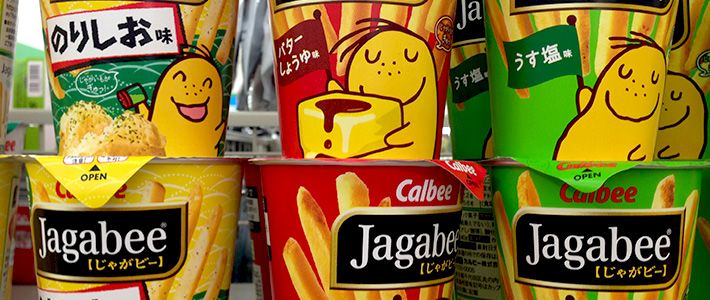
Savory Snacks from Japan
Society Culture- English
- 日本語
- 简体字
- 繁體字
- Français
- Español
- العربية
- Русский
“Can’t Give ’Em Up, Can’t Stop Eating ’Em”
 Kappa Ebisen snack (© Calbee).
Kappa Ebisen snack (© Calbee).
Kappa Ebisen, one of the most famous Japanese snacks, is made from four types of shrimps minced in their shells and mixed together with flour, salt, and calcium. It was created in 1964 and has been popular for over 50 years, while the slogan Yamerarenai tomaranai (Can’t give ’em up, can’t stop eating ’em), used in advertising jingles since 1969, is still well-known today. The crunchy sticks have also won fans overseas, with flavor and mouthfeel subtly adapted to meet local tastes. Around 6.5 billion bags have been sold to date worldwide, a sales pace adding up to enough shrimp snacks to stretch around the globe twice each month if laid end to end. There are production sites in the United States and Europe as well as China, Taiwan, Thailand, and other Asian countries.
Jagariko and Jagabee snacks, made from steamed potatoes that have been cut into sticks and fried, are also popular with children and young people. This is due to their variety of flavors, including seasonal offerings, and the firm crunchiness of the sticks.
Japanese-Style Potato Chips
The whole world enjoys potato chips, but they have evolved slightly differently in Japan, as manufacturers have developed innovative flavors to appeal to the national palate. As well as the classic varieties of salt, nori (seaweed), and consommé, there are such common seasonings as umeboshi (pickled plum), soy sauce and mayonnaise, wasabi, chili, pizza, and mentaiko (spicy pollock roe).
Soy sauce, an essential part of Japanese cuisine, often combines with other ingredients to create new flavors. In Hokkaidō, there are chips that blend soy sauce with local butter, while in the Kansai region, soy sauce dashi chips are on sale.
 Varieties of potato chips from shrimp mustard mayonnaise to French salad.
Varieties of potato chips from shrimp mustard mayonnaise to French salad.
Researchers, sensitive to subtle variations in flavor, are constantly developing new kinds of chips, whether they are looking to harness local ingredients or deliver an umami effect.
Luxury Chips
 Chocolate potato chips (© Royce Confect). Potato chips coated with chocolate or topped with real cheese also provide a taste experience to Japanese consumers.
Chocolate potato chips (© Royce Confect). Potato chips coated with chocolate or topped with real cheese also provide a taste experience to Japanese consumers.
 Luxury potato chips (left) alongside ordinary chips (right).
Luxury potato chips (left) alongside ordinary chips (right).
Another recent trend is potato chips that are three times thicker than normal. While a bag of ordinary chips costs around ¥150, these luxury chips retail for over ¥500 in some department stores and are only on sale between October and March. Despite their high price, Japanese customers line up to buy them as gifts or special treats for themselves.
Major snack manufacturers like Calbee, Meiji, Glico, and Morinaga have established antenna shops in Tokyo and other cities—including Tokyo Okashi Land in Tokyo Station—where visitors can observe the manufacturing process and eat the snacks freshly made.
Photo credits: Luxury potato chips and ordinary chips: Gorimon▼Further reading
 Pocky Heads Overseas: Japanese Snack Brands Earning a Global Following
Pocky Heads Overseas: Japanese Snack Brands Earning a Global Following